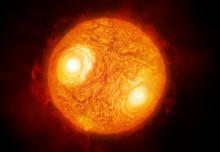Listen to today's episode of StarDate on the web the same day it airs in high-quality streaming audio without any extra ads or announcements. Choose a $8 one-month pass, or listen every day for a year for just $30.
You are here
Moon and Antares
Scorpius is one the most prominent constellations around. Antares, its leading light, is one of the brightest and reddest stars in the night sky. And Scorpius has many other fairly bright stars, which form the easy-to-see outline of a scorpion.
If we could see Scorpius at ultraviolet wavelengths, though, it would look even brighter. That’s because the constellation is home to many stars that are young and hot — tens of thousands of degrees hotter than the Sun.
Such stars are extremely bright at visible wavelengths. But because they’re so hot, they produce much more light in the ultraviolet.
The stars are so hot because they’re much heavier than the Sun. Their gravity squeezes their cores tightly, revving up their nuclear reactions. Radiation from the hot cores heats the stars’ outer layers, making them shine blue-white.
One of the few bright stars in Scorpius that wouldn’t look brighter in the ultraviolet is Antares, which is far to the lower left of the Moon tonight, and closer below the Moon tomorrow night.
Antares consists of two stars. The heavier of the two has undergone big changes in its core. That’s caused the star to puff up, cooling its outer layers. So it produces most of its energy in the infrared.
Antares wouldn’t disappear in the ultraviolet, though, because the smaller companion is much hotter. So like many of the bright stars around Antares, it glows brightly in the ultraviolet.
More about ultraviolet astronomy tomorrow.



